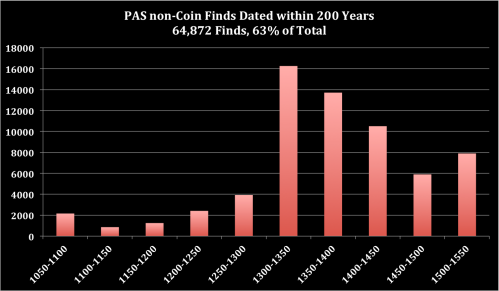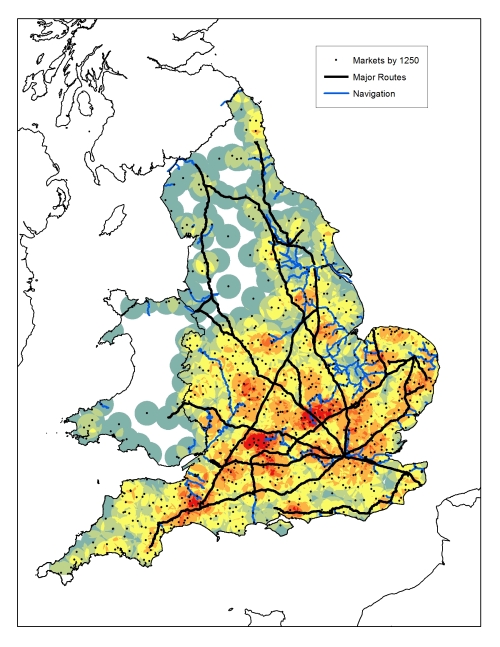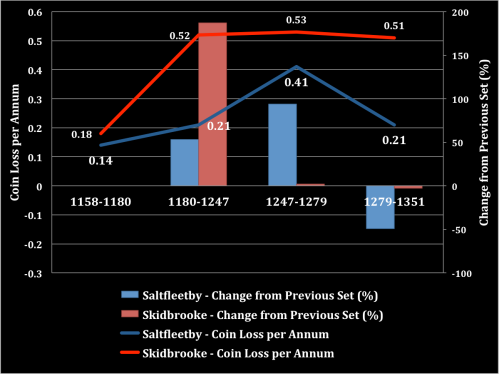Michael Lewis and Eljas Oksanen, Portable Antiquities Scheme
Medieval Markets and the Portable Antiquities Scheme
The Portable Antiquities Scheme (PAS) was set up in 1997 to record small archaeological finds made by members of the public, mostly by metal-detecting. Managed by the British Museum and with a network of Finds Liaison Officers, interns and volunteers across England and Wales, the scheme’s online database (finds.org.uk) describes over a million objects with more than 80,000 being added every year. These finds cover a vast range of material culture from neolithic arrowheads to medieval coins and post-medieval candlesticks. The ‘medieval’ (1066-1540) dataset is the second largest by chronological period, and contains some 165,000 objects with more added every day. The medieval portion of the dataset has not been examined as thoroughly as, for example, the Roman. Consequently the GIS-led project Placing Medieval Markets in their Landscape Context through the Portable Antiquities Scheme Data at the British Museum aims to evaluate it in the context of studying the emergence, growth and decline of medieval commerce, markets and fairs.
As a national dataset the PAS finds are evidence of the use and availability of metalwork objects across long periods of time. For example, Figure 1 shows the chronological breakdown of some 65,000 medieval PAS non-coin finds that have been dated to within 200 years. A substantial increase in the numbers of finds to the fourteenth century is followed by a period of clear decline, before finds start to pick up again in the sixteenth century. Perhaps unsurprisingly, the PAS data therefore reflects both the population and economic growth across the Central Middle Ages, and the demographic catastrophe of the Black Death (first arriving in 1348 to England). The difficulty in the close dating of these objects is a challenge to any temporal investigation of the PAS database, of course, but it is lent greater credence through comparative analysis with other independent datasets. Martin Allen’s research on the amount of coinage in circulation, and Carenza Lewis’ ceramics data from 1,700 test pits dug in eastern English rural settlements, reflect a very similar decline from around the mid-fourteenth century. Together these speak for a more maximalist interpretation of the impact of the Black Death on economic and consumer activity.
Figure 1

An area of particular interest to our project is the relationship of the PAS data to rural market sites. These served as a point of access to commercial networks for the vast majority of the medieval population, while at the same time being poorly served by documentary sources. Weekly markets were a key component of peasant economy through the Middle Ages, and over the last few decades there has been a growing awareness that local village economies were often connected to broader networks of exchange at an early stage. Already by the twelfth century there had emerged commercial networks that linked weekly markets and small towns to regional urban centres, which in turn served as nexus-points of long-distance trade.
There is a general geographic association between the PAS data and medieval settlements that possessed markets. One-fifth of all medieval finds were made within 1 km of a known medieval market town, or a land area that is only about one-twentieth of the total area of England. Likewise, on a national level there are differences between the compositions of PAS finds near market towns and the total population of all finds. Statistical analyses of the data shows that some objects are much more likely to be found near settlements that had hosted a market, in particular those successful and long-lived medieval markets that survived to the Early Modern Period, which is helpful for establishing distinctions between the material cultural profiles of urban and rural sites. For example pilgrim badges are found in average three times more commonly in the vicinity of a market, or over six times near a market that survived to the Early Modern Period. Such information can offer insight on the religious life, or indeed the opportunities for long-distance travel enjoyed by different populations.
The spatial and temporal distribution of PAS finds can also be used to investigate varying intensities of economic activity. Figure 2 maps the broad national pattern of marketing that had emerged by the mid-thirteenth century, based on market charters or direct evidence of market activity. (S. Letters, Gazetteer of Markets and Fairs in England and Wales to 1516, 2002, radius = 16 km) While nearly everywhere in England was within a day’s return journey of at least one market site, regions of high or low density activity demonstrate how populations in different areas enjoyed varying degrees of access to multiple, presumably competing franchises. The medium-to-high density region around London, for example, must have been connected to the economy of the city. But the three ‘hottest’ areas were, from left to right, at the Somerset Levels, where the London-Exeter road meets of the Foss Way near waterways discharging into the Bristol Channel; at the upper navigable reaches of the Thames, at a place which the Droitwich Saltways had marked since the Anglo-Saxon period as a major stepping stone between the water highways of the Thames and the Severn; and finally near the intersection of the Icknield Way, the Watling Street and the river Great Ouse.
Figure 2

These unusual densities of local markets are located around intersections of major cross-country long-distance routes, and also at places that mark the transfer from one form of transportation to another, such as a boat or a ship to a cart or a packhorse. Such zones are evidence that many successful local markets were integrated into broader networks of interregional and perhaps even international exchange, and also highlights their key role in the development of the British medieval economy. The PAS data supports this argument: a high concentration of coin finds indicates that a markedly high level of commercial exchange along the Icknield Way in eastern Midlands dated back to the Anglo-Saxon period, long before significant written records on formal market activity had become available.
The PAS data holds the potential to fill in gaps left by the often very limited documentary evidence on local commerce. Owing to the industriousness of local metal-detectorists, there is high yield of PAS data from around the medieval vills of Saltfleetby and Skidbrooke in coastal Lincolnshire. Saltfleetby was an old economic centre attested in Domesday Book of 1086, but its commercial pre-eminence was usurped by the neighbouring Skidbrooke by the fourteenth century. The pattern of single finds of coins made in the vicinity of the two settlements in Figure 3 starkly illustrates Saltfleetby’s economic decline. In this case it was possible to confirm the changing fortunes of the two vills from written sources, but what our project aims to demonstrate is how a critical approach to the PAS data offers the opportunity to map long-term trends unattainable through other means – ideally including in places not covered by written evidence. The power of the PAS data is founded in its extraordinary spatial and temporal reach across England and Wales, enabling the study of historical developments equally at local and national levels.
Figure 3

Michael Lewis – mlewis@britishmuseum.org
Eljas Oksanen – e.i.oksanen@cantab.net
For more on the project and the PAS see:
‘Medieval Markets and Portable Antiquities Scheme’, E. Oksanen and M. Lewis, in Medieval Settlement Research 30 (Medieval Settlement Research Group, London, 2015), 54-9.
‘Exploring the Commercial Landscape of Medieval Saltfleetby and Skidbrooke, Lincolnshire, through PAS Data’, E. Oksanen and M. Lewis, in Medieval Archaeology 59 (forthcoming).
Project website: medievalmarketsites.wordpress.com
PAS: finds.org.uk

Pingback: ‘Medieval Markets and the Portable Antiquities Scheme’ blog | Association française d'histoire économique
Amazing information shared…..
Medieval Coins